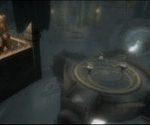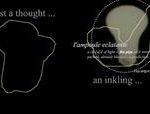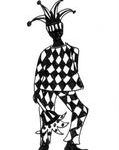2008
Robert Nideffer describes a multi-modal game in which the player will be more impressed with the number of media the game engages than with its (unexceptional) main character.
Nick Fortugno describes a live-action role-playing game with a real-world consequence - a marriage proposal.
Jane McGonigal argues that pervasive games - which involve electronic and 'real world' missions - reverse the traditional conception of the power dynamics of gaming, which has understood gamers as free agents. In contrast, according to McGonigal, designers of pervasive games exercise power over players, though their control is ultimately compromised by players' interpretive agency.
Teri Rueb describes Itinerant and quotes excerpts from the project's vocal track. The installation-style piece uses a GPS system and a headset. As the participant walks through the allotted space, the GPS cues various recordings. Rueb claims to want "to implicate the participant as a charged body in public space whose movement and presence become critical agents in structuring the meaning of the work."
Sean Thorne explains how he uses Puppetland to help children improve their writing. The RPG allows the students to develop characters, and to participate in the construction of stories so that they're imaginatively invested in what they write.
Kevin Whelan argues that there's not much difference between role-playing games and grass-roots political activism.
John Tynes argues that it took the novel two hundred years to gain cultural capital; film, forty years; rock and roll, fifteen. Given this increasing velocity and the fact that it's been three decades since Colossal Cave Adventure, interactive storytelling should have gained a much higher level of respect than it has. Tynes argues that games should eschew escapist fantasy for more timely "engagist" settings that would allow the player to reflect on contemporary life and politics.
Corvus Elrod extends Bruno Faidutti's claim that all games tell stories by making the counter-intuitive argument that board games like Chess and Go are more effective story vehicles than RPGs.
David Parry argues that Pax occupies a position between literature and games - that it "glorifies play while undermining games," and that it's "not so much literature as it is literary."
Jesper Juul argues that James Wallis's focus on definitions in his intervention into the story/game debate doesn't give the experience of story - or game - its due.
Monica Evans extends Costikyan's analysis of the narrative/game debate, but ultimately concludes that battles over genre categorization miss the point of electronic media, and that we cannot yet accurately assess how the tension between story and play works out because digital games are "products of a technology still in its infancy."
Jason Rhody argues that Prince of Persia: The Sands of Time attains the status of a game fiction by leveraging "narrative tragedy" to enhance "ludic complexity" - creating a game in which narrative and play, far from being opposed, as in most assessments, enhance one another.
Editors Pat Harrigan and Noah Wardrip-Fruin introduce the essays of the "Computational Fictions" section of Second Person, focusing on the conversion of human ludic interaction into computational processes - a necessary condition for computer games.
Mark Marino explains Twelve Easy Lessons to Better Time Travel as an allegory of electronic writing, featuring characters that represent salient figures from Alan Turing to Shelley Jackson.
Marie-Laure Ryan describes Juvenate as an audiovisual hypertext that can be navigated via a provided map or wandered through like a maze, evoking the question of whether the text is best understood as a narrative or a game.
Lev Manovich describes a filmic methodology for the information age: narratives structured on the logic of databases. The delegation of a large part of the editing Mission to Earth to a computer results in a product that is "between narrative and a search engine."
Emily Short explains that one of the goals of Savoir-Faire is to teach the player to become a magician. This pedagogical orientation means that - in contrast to interactive fictions that allow only a severely limited range of player input - Short's game rewards undirected play because the player is not only solving puzzles, but also learning.
Talan Memmott describes The Brotherhood of Bent Billiard as "a narrative hack of Magritte's symbolic calculus"; it allows the reader to negotiate a number of clickable Magritte-inspired screens, which provide the reader a forum for thinking through the questions of representation immanent in the painter's work.
Steve Meretzky reflects on one of the earliest (1982) NPCs (non-player characters) to evoke an emotional investment from videogame players. Meretzky draws attention to the fact that character development - integral to fiction and film - is not often emphasized in game design.
Helen Thorington describes Solitaire, a program for generating fiction in the same line as the projects explained by Chris Crawford and D. Fox Harrell elsewhere in this thread.










